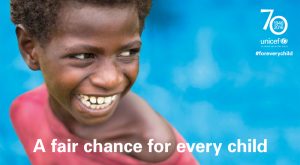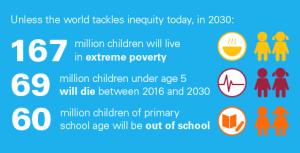
If the soul of a society can be judged by the way it treats its most vulnerable members, then by a similar measure, a society’s future – its long-term prospects for sustainable growth, stability and shared prosperity – can be predicted by the degree to which it provides every child with a fair chance in life. Providing every child with that fair chance is the essence of equitable development. And as this edition of The State of the World’s Children argues, promoting equity is more than a moral obligation. It is both a practical and a strategic imperative, helping to break intergenerational cycles of disadvantage and thus reducing the inequalities that undermine all societies.
Every child is born with the same inalienable right to a healthy start in life, an education and a safe, secure childhood – all the basic opportunities that translate into a productive and prosperous adulthood. But around the world, millions of children are denied their rights and deprived of everything they need to grow up healthy and strong – because of their place of birth or their family of origin; because of their race, ethnicity or gender; or because they live in poverty or with a disability.

This report’s call to action is, therefore, motivated by a sense of urgency and the conviction that a different outcome, and a better world, are possible. Children born into poverty and deprivation are not doomed to live lives of despair. Inequity is not inevitable, if governments invest in expanding opportunity for every child – shifting policies, programming and public spending priorities so the most disadvantaged have a chance to catch up with the most advantaged.
As the report shows, the good news is that there are more effective – and costeffective – ways to reach the hardest-to-reach children, families and communities. New technology, the digital revolution, innovative ways to finance critical interventions and citizen-led movements are all helping to drive change for the most disadvantaged. Investing in these interventions and initiatives, and fuelling these emergent movements, will yield both short- and long-term benefits for millions of children and their societies.
The arithmetic of equity is relatively simple, and it is not a zero-sum game. Everyone should move forward, in rich and poor countries alike. But with greater investment and effort focused on reaching the children and families who have made the least progress, advances in child survival, health and education can be more equally shared to the benefit of all. To realize our global development goals, we must invest first in the children who are furthest behind.
Investing in the most disadvantaged is not only right in principle. Evidence shows that it is also right in practice. In a 2010 study,1 UNICEF demonstrated that an equity-focused approach would accelerate progress towards global health goals faster than could be achieved by the current path and would be especially costeffective in low-income, high-mortality countries.
The study was based on a simulation that tested two scenarios for achieving maternal and child health goals. One approach emphasized a greater effort to reach children who were worse off. The other was a stay-the-course method that did not place special emphasis on the disadvantaged.
Two key findings emerged: First, by addressing the concentration of various forms of inequity in the most disadvantaged populations, an equity approach accelerated progress towards realizing the health goals faster than the stay-the-course path. Second, by averting more deaths with the same financial investments, the equity approach was considerably more cost-effective and sustainable than the alternative.
So investing in equity is not only a moral necessity. It is a practical and strategic imperative as well.